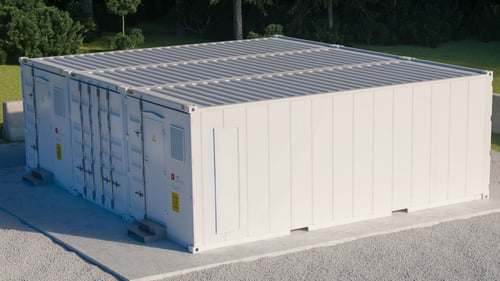Maximising BESS Earnings: 5 Key Revenue Models

Maximising the value of Battery Energy Storage Systems (BESS) depends on more than just cutting-edge technology; it also requires clear financial insight and commercial flexibility. When deciding on an optimiser, beyond revenue forecasting, BESS project owners must consider which revenue models best align with their unique goals.
Continue reading this article to discover which revenue model fits your needs and challenges, or watch the replay of our webinar "Maximise battery revenue: building bankable projects with long-term ROI" by clicking on the image below.

Jump to:
- Sympower's Data-Driven Revenue Forecasting Approach
- Revenue Share: Shared Upside, Shared Risk
- Performance-Based Revenue Share: Aligned Incentives
- Floors: Minimum Guaranteed Revenue
- Tolling: Fixed, Pre-Agreed Revenue
- SaaS Subscription: Optimisation as a Service
Sympower's Data-Driven Revenue Forecasting Approach
To estimate gross revenues for each BESS asset, Sympower combines historical performance data with internal and external market price projections, before simulating different scenarios. This approach enables us to simulate how your asset could perform under various market conditions, across different timeframes and services.
We incorporate key technical characteristics, such as battery duration, degradation rates, and round-trip efficiency, to ensure that our forecasts reflect the operational reality of each system. By modelling market dynamics at a granular level, we help asset owners make informed decisions, whether they’re evaluating a new project or optimising an existing one.
Because every BESS project is unique, with different financial objectives and risk appetites, battery project owners and developers must carefully select the revenue model that best meets their specific needs and risk preferences, each with its pros and cons.
Each revenue model varies in how it distributes risks between the project owner and the optimiser.
Revenue Share: Shared Upside, Shared Risk
One of the most common options on the market, where the project owner and the optimiser share revenues from the BESS operations, according to a pre-agreed percentage split in favour of the project owner. This structure creates a shared incentive, since the optimiser's performance will directly affect its own revenue. This model therefore encourages continuous performance optimisation and market responsiveness.
Best suited for: asset owners seeking high market exposure and flexibility.
| Benefits | Challenges |
|
|
Performance-Based Revenue Share: Aligned Incentives
In this increasingly more popular model, the optimiser's share of revenue depends on their performance. Rather than a fixed percentage, the rate is dynamic and ideally benchmarked live. It provides more incentives for the optimiser to perform well, as it rewards high performance and penalises underperformance.
Best suited for: asset owners seeking high market exposure and partnering with mature optimisers.
| Benefits | Challenges |
|
|
Floors: Minimum Guaranteed Revenue
Unlike the two previous models, here the optimiser guarantees a minimum annual revenue to the asset owner (the "floor"). Revenue beyond that threshold is shared between the project owner and the optimiser. If the project performs below the minimum guarantee, the optimiser must pay the difference. In return for taking on that increased risk, the optimiser usually receives a greater share of the upside.
Revenue floors provide project bankability and can be particularly valuable when securing financing or when exposure to merchant market volatility is a concern.
Best suited for: experienced BESS developers or owners with a good track record seeking bankability and more stability, and willing to forgo some revenue for reduced risk.
| Benefits | Challenges |
|
|
What an offer looks like (illustrative only):
| Floor value (€/MW/year) | |||||
| 2026 | 2027 | 2028 | 2029 | 2030 | |
| 100 000 | 100 000 | 100 000 | 100 000 | 100 000 | |
| Revenue % above floor | +50% | +50% | +50% | +50% | +50% |
- The project owner will receive at least € 100,000 per megawatt per year (floor value).
- Any revenue above that floor is shared 50/50 between the project owner and the optimiser. Contrast this with traditional revenue share models, where the optimiser typically receives only 3–10% of revenues.
Tolling: Fixed, Pre-Agreed Revenues
Tolling is another type of revenue guarantee model, where the optimiser guarantees a fixed payment to the project owner. Revenues generated above that level are allocated to the optimiser in their entirety - they are not shared with the project owner. If the project performs below the minimum guarantee, the optimiser pays the difference. In this set-up, the optimiser takes on the full responsibility and risk of the market optimisation.
This revenue model provides the asset owner with predictable income while offloading operational complexity. It also enhances bankability, enabling developers to secure financing for their projects.
Best suited for risk-averse investors seeking secure and predictable revenue with minimal market exposure.
| Benefits | Challenges |
|
|
SaaS Subscription: Optimisation as a Service
In this less common model, the project owner retains full operational control of its assets and pays the optimiser a fixed fee, typically in return for the use of a trading platform software. This model suits project owners who want to self-manage trading and operations, such as automating asset scheduling and activations, ensuring market and TSO compliance, and streamlining settlement and reporting.
In this setting, the project owner gains access to optimisation software that can handle bidding and interface with all the other required platforms, as well as provide assistance with trading strategies.
Best suited for: investors and project owners who want to take a hands-on approach to trading the batteries themselves, and who may have their own in-house trading team.
| Benefits | Challenges |
|
|
Whether you're looking for hands-on control, guaranteed returns, or a fully outsourced solution, Sympower offers a path forward. Our goal is to ensure that every BESS asset delivers optimal value today and into the future.
Let’s talk about the revenue model that works best for you: contact our BESS team!
PDF Summary - BESS Revenue Models
Get a free summary of the different revenue models for BESS projects to help you decide which best suits your needs.
Other articles you might find interesting
-
.jpg?length=500&name=electric%20boiler%20(1).jpg) BESS3 June 2025
BESS3 June 2025Beyond revenue potential: navigating the technical complexities of BESS optimisation
Read more -
 BESS3 June 2025
BESS3 June 2025Maximise Battery Revenue: How to Build a Successful Business Case
Read more -
 BESS3 June 2025
BESS3 June 2025The Greek BESS Opportunity: One Market Won’t Do
Read more -
 BESS3 June 2025
BESS3 June 2025Unlocking BESS’ Full Potential: Why Multi-Market Trading is the Future
Read more -
 BESS3 June 2025
BESS3 June 2025Harnessing BESS’ Potential in the Nordics: Key Insights from our Webinar
Read more -
 BESS3 June 2025
BESS3 June 2025What is Battery Storage?
Read more